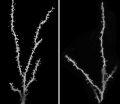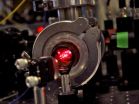(Press-News.org) NEW YORK, NY (August 21, 2014) — Children and adolescents with autism have a surplus of synapses in the brain, and this excess is due to a slowdown in a normal brain "pruning" process during development, according to a study by neuroscientists at Columbia University Medical Center (CUMC). Because synapses are the points where neurons connect and communicate with each other, the excessive synapses may have profound effects on how the brain functions. The study was published in the August 21 online issue of the journal Neuron.
A drug that restores normal synaptic pruning can improve autistic-like behaviors in mice, the researchers found, even when the drug is given after the behaviors have appeared.
"This is an important finding that could lead to a novel and much-needed therapeutic strategy for autism," said Jeffrey Lieberman, MD, Lawrence C. Kolb Professor and Chair of Psychiatry at CUMC and director of New York State Psychiatric Institute, who was not involved in the study.
Although the drug, rapamycin, has side effects that may preclude its use in people with autism, "the fact that we can see changes in behavior suggests that autism may still be treatable after a child is diagnosed, if we can find a better drug," said the study's senior investigator, David Sulzer, PhD, professor of neurobiology in the Departments of Psychiatry, Neurology, and Pharmacology at CUMC.
During normal brain development, a burst of synapse formation occurs in infancy, particularly in the cortex, a region involved in autistic behaviors; pruning eliminates about half of these cortical synapses by late adolescence. Synapses are known to be affected by many genes linked to autism, and some researchers have hypothesized that people with autism may have more synapses.
To test this hypothesis, co-author Guomei Tang, PhD, assistant professor of neurology at CUMC, examined brains from children with autism who had died from other causes. Thirteen brains came from children ages two to 9, and thirteen brains came from children ages 13 to 20. Twenty-two brains from children without autism were also examined for comparison.
Dr. Tang measured synapse density in a small section of tissue in each brain by counting the number of tiny spines that branch from these cortical neurons; each spine connects with another neuron via a synapse.
By late childhood, she found, spine density had dropped by about half in the control brains, but by only 16 percent in the brains from autism patients.
"It's the first time that anyone has looked for, and seen, a lack of pruning during development of children with autism," Dr. Sulzer said, "although lower numbers of synapses in some brain areas have been detected in brains from older patients and in mice with autistic-like behaviors."
Clues to what caused the pruning defect were also found in the patients' brains; the autistic children's brain cells were filled with old and damaged parts and were very deficient in a degradation pathway known as "autophagy." Cells use autophagy (a term from the Greek for self-eating) to degrade their own components.
Using mouse models of autism, the researchers traced the pruning defect to a protein called mTOR. When mTOR is overactive, they found, brain cells lose much of their "self-eating" ability. And without this ability, the brains of the mice were pruned poorly and contained excess synapses. "While people usually think of learning as requiring formation of new synapses, "Dr. Sulzer says, "the removal of inappropriate synapses may be just as important."
The researchers could restore normal autophagy and synaptic pruning—and reverse autistic-like behaviors in the mice—by administering rapamycin, a drug that inhibits mTOR. The drug was effective even when administered to the mice after they developed the behaviors, suggesting that such an approach may be used to treat patients even after the disorder has been diagnosed.
Because large amounts of overactive mTOR were also found in almost all of the brains of the autism patients, the same processes may occur in children with autism.
"What's remarkable about the findings," said Dr. Sulzer, "is that hundreds of genes have been linked to autism, but almost all of our human subjects had overactive mTOR and decreased autophagy, and all appear to have a lack of normal synaptic pruning. This says that many, perhaps the majority, of genes may converge onto this mTOR/autophagy pathway, the same way that many tributaries all lead into the Mississippi River. Overactive mTOR and reduced autophagy, by blocking normal synaptic pruning that may underlie learning appropriate behavior, may be a unifying feature of autism."
Alan Packer, PhD, senior scientist at the Simons Foundation, which funded the research, said the study is an important step forward in understanding what's happening in the brains of people with autism.
"The current view is that autism is heterogeneous, with potentially hundreds of genes that can contribute. That's a very wide spectrum, so the goal now is to understand how those hundreds of genes cluster together into a smaller number of pathways; that will give us better clues to potential treatments," he said.
"The mTOR pathway certainly looks like one of these pathways. It is possible that screening for mTOR and autophagic activity will provide a means to diagnose some features of autism, and normalizing these pathways might help to treat synaptic dysfunction and treat the disease."
The paper is titled, "Loss of mTOR-dependent macroautophagy causes autistic-like synaptic pruning deficits." Other authors are: Kathryn Gudsnuk, Sheng-Han Kuo, Marisa L. Cotrina, Gorazd Rosoklija, Alexander Sosunov, Mark S. Sonders, Ellen Kanter, Candace Castagna, Ai Yamamoto, Ottavio Arancio, Bradley S. Peterson, Frances Champagne, Andrew J. Dwork, and James Goldman from CUMC; and Zhenyu Yue (Icahn School of Medicine at Mount Sinai). Marisa Cotrina is now at the University of Rochester.
The authors declare no competing financial interests.
This study was supported by the Simons Foundation, with additional funding from the U.S. Department of Defense (TS110056), the Parkinson’s Disease Foundation, JPB Foundation, National Institutes of Health (K01MH096956, R01MH64168, DP2OD001674, R01NS049442), and the American Heart Association. Harvard Brain Bank and Maryland NICHD Brain & Tissue Bank provided brain tissue.
Columbia University Medical Center provides international leadership in basic, preclinical, and clinical research; medical and health sciences education; and patient care. The medical center trains future leaders and includes the dedicated work of many physicians, scientists, public health professionals, dentists, and nurses at the College of Physicians and Surgeons, the Mailman School of Public Health, the College of Dental Medicine, the School of Nursing, the biomedical departments of the Graduate School of Arts and Sciences, and allied research centers and institutions. Columbia University Medical Center is home to the largest medical research enterprise in New York City and State and one of the largest faculty medical practices in the Northeast. For more information, visit cumc.columbia.edu or columbiadoctors.org.
Children with autism have extra synapses in brain
May be possible to prune synapses with drug after diagnosis
2014-08-21
ELSE PRESS RELEASES FROM THIS DATE:
Research explains how cellular guardians of the intestine develop
2014-08-21
Even the most careful chosen meal can contain surprises. To defend against infectious microbes, viruses or other potential hazards that find their way to the intestines, a dedicated contingent of immune cells keeps watch within the thin layer of tissue that divides the contents of the gut from the body itself.
New research at Rockefeller University sheds light on the development of a unique class of immune cells known as intraepithelial lymphocytes (IELs) that reside in this critical interface. The findings, published August 21 in Immunity, may help lead to new insights ...
Alternate mechanism of species formation picks up support, thanks to a South American ant
2014-08-21
A newly-discovered species of ant supports a controversial theory of species formation. The ant, only found in a single patch of eucalyptus trees on the São Paulo State University campus in Brazil, branched off from its original species while living in the same colony, something thought rare in current models of evolutionary development.
“Most new species come about in geographic isolation,” said Christian Rabeling, assistant professor of biology at the University of Rochester. “We now have evidence that speciation can take place within a single colony.”
The findings ...
Mouse model for epilepsy, Alzheimer's gives window into the working brain
2014-08-21
(SALT LAKE CITY)—University of Utah scientists have developed a genetically engineered line of mice that is expected to open the door to new research on epilepsy, Alzheimer's and other diseases.
The mice carry a protein marker, which changes in degree of fluorescence in response to different calcium levels. This will allow many cell types, including cells called astrocytes and microglia, to be studied in a new way.
"This is opening up the possibility to decipher how the brain works," said Petr Tvrdik, Ph.D., a research fellow in human genetics and a senior author ...
Hacking Gmail with 92 percent success
2014-08-21
RIVERSIDE, Calif. — A team of researchers, including an assistant professor at the University of California, Riverside Bourns College of Engineering, have identified a weakness believed to exist in Android, Windows and iOS mobile operating systems that could be used to obtain personal information from unsuspecting users. They demonstrated the hack in an Android phone.
The researchers tested the method and found it was successful between 82 percent and 92 percent of the time on six of the seven popular apps they tested. Among the apps they easily hacked were Gmail, CHASE ...
Researchers identify potential risk factors for urinary tract infections in young girls
2014-08-21
Winston-Salem, N.C. – August, 21, 2014 – Young girls with an intense, red, itchy rash on their outer genital organs may be at increased risk of developing urinary tract infections (UTIs), according to new research from Wake Forest Baptist Medical Center. The treatment may be as simple as better hygiene and avoiding potential irritants such as bubble baths and swimming pools.
"Vulvitis is a common condition affecting women and girls of all ages," said senior author Steve J. Hodges, M.D., associate professor of urology at Wake Forest Baptist. "We found that girls with ...
Difficulty assessing effort drives motivation deficits in schizophrenia, study finds
2014-08-21
SAN FRANCISCO, Aug. 21, 2014 – Individuals with schizophrenia often have trouble engaging in daily tasks or setting goals for themselves, and a new study from San Francisco State University suggests the reason might be their difficulty in assessing the amount of effort required to complete tasks.
The research, detailed in an article published this week in the Journal of Abnormal Psychology, can assist health professionals in countering motivation deficits among patients with schizophrenia and help those patients function normally by breaking up larger, complex tasks into ...
A NASA satellite double-take at Hurricane Lowell
2014-08-21
Lowell is now a large hurricane in the Eastern Pacific and NASA's Aqua and Terra satellites double-teamed it to provide infrared and radar data to scientists. Lowell strengthened into a hurricane during the morning hours of August 21.
When NASA's Aqua satellite passed over Lowell on August 20 at 21:05 UTC (4:05 p.m. EDT), the Atmospheric Infrared Sounder got an infrared look at Lowell's cloud top temperatures when it was still a tropical storm. AIRS showed a very thick band of thunderstorms surrounding the center of circulation and what appeared to be a very small cloud-free ...
Researchers examine impact of race and ethnicity in motor complete spinal cord injury
2014-08-21
West Orange, NJ. August 21, 2014. Researchers have published a study examining racial and ethnic influences in the outcomes of patients with motor complete spinal cord injury (SCI). The article, "Racial and ethnic disparities in functioning at discharge and follow-up among patients with motor complete SCI," was published online ahead of print on August 2 by the Archives of Physical Medicine & Rehabilitation (doi: 10.1016/j.apmr.2014.07.398). Findings included small but significant differences in self-care and mobility at discharge; no differences were apparent at 1-year ...
Reading 'Fifty Shades' linked to unhealthy behaviors
2014-08-21
EAST LANSING, Mich. --- Young adult women who read "Fifty Shades of Grey" are more likely than nonreaders to exhibit signs of eating disorders and have a verbally abusive partner, finds a new study led by a Michigan State University researcher.
Further, women who read all three books in the blockbuster "Fifty Shades" erotic romance series are at increased risk of engaging in binge drinking and having multiple sex partners.
All are known risks associated with being in an abusive relationship, much like the lead character, Anastasia, is in "Fifty Shades," said Amy Bonomi, ...
Yale's cool molecules
2014-08-21
New Haven, Conn. – It's official. Yale physicists have chilled the world's coolest molecules.
The tiny titans in question are bits of strontium monofluoride, dropped to 2.5 thousandths of a degree above absolute zero through a laser cooling and isolating process called magneto-optical trapping (MOT). They are the coldest molecules ever achieved through direct cooling, and they represent a physics milestone likely to prompt new research in areas ranging from quantum chemistry to tests of the most basic theories in particle physics.
"We can start studying chemical reactions ...
LAST 30 PRESS RELEASES:
University of Oklahoma researcher awarded funding to pursue AI-powered material design
Exploring how the visual system recovers following injury
Support for parents with infants at pediatric check-ups leads to better reading and math skills in elementary school
Kids’ behavioral health is a growing share of family health costs
Day & night: Cancer disrupts the brain’s natural rhythm
COVID-19 vaccination significantly reduces risk to pregnant women and baby
The role of vaccination in maternal and perinatal outcomes associated with COVID-19 in pregnancy
Mayo Clinic smartwatch system helps parents shorten and defuse children's severe tantrums early
Behavioral health spending spikes to 40% of all children’s health expenditures, nearly doubling in a decade
Digital cognitive behavioral treatment for generalized anxiety disorder
Expenditures for pediatric behavioral health care over time and estimated family financial burden
Air conditioning in nursing homes and mortality during extreme heat
The Alps to lose a record number of glaciers in the next decade
What makes a good proton conductor?
New science reporting guide published for journalists in Bulgaria
New international study reveals major survival gaps among children with cancer
New science reporting guide published for journalists in Turkey
Scientists develop a smarter mRNA therapy that knows which cells to target
Neuroanatomy-informed brain–machine hybrid intelligence for robust acoustic target detection
Eight SwRI hydrogen projects funded by ENERGYWERX
The Lundquist Institute and its start-up company Vitalex Biosciences Announces Strategic Advancement of Second-Generation fungal Vaccine VXV-01 through Phase 1 Trials under $40 Million Competitive Con
Fine particles in pollution are associated with early signs of autoimmune disease
Review article | Towards a Global Ground-Based Earth Observatory (GGBEO): Leveraging existing systems and networks
Penn and UMich create world’s smallest programmable, autonomous robots
Cleveland researchers launch first major study to address ‘hidden performance killer’ in athletes
To connect across politics, try saying what you oppose
Modulating key interaction prevents virus from entering cells
Project explores barriers to NHS career progression facing international medical graduates
Jeonbuk National University researchers explore the impact of different seasonings on the flavor perception of Doenjang soup
Two Keck Medicine of USC Hospitals named Leapfrog Top Teaching Hospitals
[Press-News.org] Children with autism have extra synapses in brainMay be possible to prune synapses with drug after diagnosis






